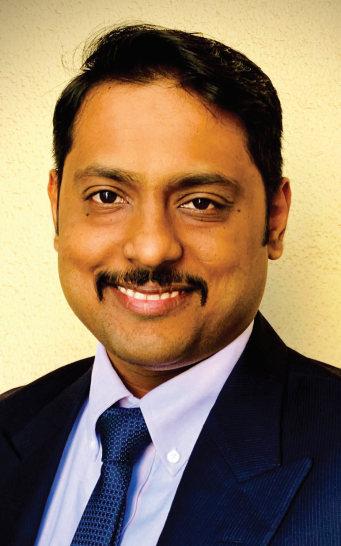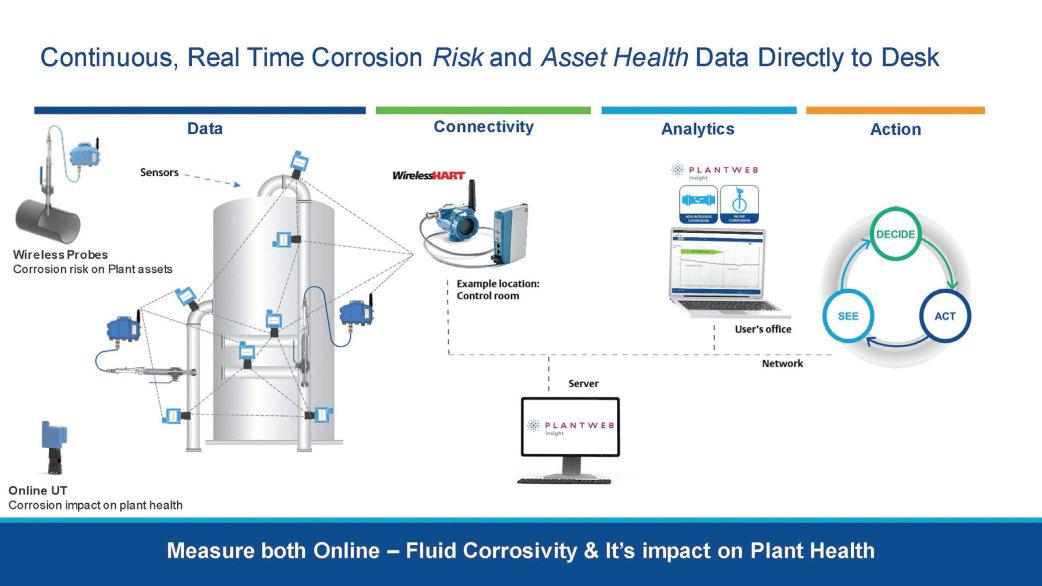
6 minute read
Addressing corrosion challenges with digital solutions
Pankaj Lahoti, MEA Corrosion & Erosion subject matter expert, Emerson Automation Solutions, discusses how digital solutions can be leveraged to improve and facilitate internal corrosion monitoring and inspection.
OIL AND GAS operators across the Middle East face tremendous pressure to improve their production margins to stay competitive. Production facilities – refinery, gas plant or gas-oil separation units – are expected to reduce their operational expenditure, delay shutdowns, improve the HSE index of their facility – and achieve all of this with limited access to CAPEX budgets. Restricted personnel movement due to COVID is further restraining plant corrosion and inspection teams to conduct even the regular maintenance and inspection activities. With infrequent or reduced data collection, the threat of loss of primary containment is imminent.
Advancements in technology around connectivity and analytics provide operators with an opportunity to navigate these difficulties by digitalising their corrosion monitoring and inspection methods.
The traditional method
Oil and gas operators have been using several types of instrumentation for corrosion monitoring, and two of the most common are corrosion probes and manual ultrasonic inspection.
Intrusive corrosion (or Electrical Resistance, ER) probes have been in use for more than 60 years. They are considered a very well-established technology that often consists of an intrusive element with a sacrificial tip sitting in the fluid. It is typically made of the same material as the surrounding equipment. Data collection happens via offline dataloggers or wired connection to the control system.
On the other hand, manual ultrasonic inspection has been used for half a century and is considered a conventional technique for measuring metal wall thickness. This involves the generation of ultrasound from a transducer placed directly onto the metal surface or back wall. The reflected ultrasound or A-scan is then recorded, and the time difference or “time-of-flight” between the sending and reflected signals provides the measurement of the wall thickness. Although the technique is reliable, completing a full set of measurements for a typical production plant with thousands of corrosion measurement locations (CMLs) tends to be very time-consuming and labour-intensive. Other disadvantages associated with this technique are:
Poor repeatability – It is highly unlikely that consecutive measurements will be taken in precisely the same location by the same NDE technician. Also, the equipment used and the NDE technician's skill level can vary between measurements, introducing high variability to the measurements.
High temperatures above 100°C (212°F) can, at times, permanently damage the NDT (Non-Destructive Testing) equipment. There are also safety risks to the NDT technician at higher temperature locations.
Physical access – the NDT technician requires access to the equipment at the measurement location of interest, which involves scaffolding (possibly permanently installed) and stripping insulation to expose the metalwork to make the manual measurements, involving high costs. At times, it also delays measurement until shutdown.
Image Credit: Emerson Automation Solutions
Pankaj Lahoti, MEA Corrosion & Erosion subject matter expert, Emerson Automation Solutions.
Continuous corrosion monitoring solutions
The best practices now consist of using permanently mounted ultrasonic sensors that measure wall thickness and employ wireless data retrieval. Once deployed on critical TMLs, these sensors provide good quality and frequent data otherwise unavailable, and are cost-effective and straightforward to deploy at a scale. The information supports a wide range of operational decisions due to its sensitivity to small changes in wall thickness, robustness to extreme plant conditions (up to 600ºC), and extended battery life enabling reliable operation over the entire cycle between turnarounds. Data is transferred using industry standard Wireless HART communications to the multiple end users’ desk, allowing frequent, reliable, and safe wall thickness monitoring.
Online corrosion monitoring is only as good as the software used to analyse the data. Independent market research shows corrosion monitoring software and software services growing faster than any corrosion monitoring hardware over the next five years. Operators may gain access to an abundance of data, but knowing how to use it to produce actionable insights is the key.
Emerson Automation Solutions identified
Image Credit : Emerson Automation Solutions

this several years ago and began to develop a new application platform. Plantweb software is a web-based application platform designed for pre-configured easy analytics and actionable information. Real-time asset monitoring means providing end-users with continuous, consistent analytics instead of relying on exporting data to perform manual calculations. Abnormal situation identification allows end-users to focus on real problems rather than data gathering. Operations teams can use the continuous online data to maximise production confidently, optimise inhibition strategy and drive high-level strategic initiatives, such as crude slate optimisation (refinery).
The benefits can be extended using builtin connectors to link your corrosion data quickly and easily to external host systems, such as process historians. End users can promptly correlate process data with corrosion data and, combined with their understanding of the corrosion risk posed, seek to learn the root cause analysis of corrosion at any given time.
The inline corrosion application supports a range of wireless corrosion probes (ER, LPR, Sand, etc.). The non-intrusive corrosion application supports widely used and currently available non-intrusive ultrasonic transmitters. The corrosion software application provides end-users with the ability to monitor corrosion risk and its impact on their plants.
These solutions also fit perfectly under the digital transformation vision of major oil and gas operators in the region, and provide a means for the plant's more sustainable operation by empowering the operations team with practical decision support tools. n

Saudi Aramco Energy Ventures invests in CorrosionRADAR predictive corrosion monitoring technology
NEW INVESTMENT FROM Saudi Aramco Energy Ventures (SAEV) is driving the next phase of global growth for UK-based company CorrosionRADAR Ltd. The funding will enable CorrosionRADAR to strengthen its operations and widen efforts to address Corrosion Under Insulation (CUI) and other operational challenges through digitalisation.
This follows successful on-site installations of CorrosionRADAR predictive corrosion monitoring systems at a primary Aramco production facility.
Dr Chiraz Ennaceur, CEO at CorrosionRADAR said,
“We welcome this exciting collaboration with Saudi Aramco Energy Ventures as we step up the global response to CUI through the adoption of digital solutions. This investment demonstrates a surge of confidence from the sector in the use of real-time data systems that will accurately predict leakages and the onset of structural failure. With the worldwide cost of corrosion at US$2.5 trillion, a co-ordinated effort cannot come soon enough. CorrosionRADAR is showing that a sustainable path to increased safety and dramatically reduced costs is achievable right now, using new technology and wireless connectivity.”
CorrosionRADAR is seeing growing demand for its smart solutions as oil and gas, petrochemical and chemical companies look to make their operations safer, cleaner and more energy efficient through improved maintenance and management of their assets. Its data-driven predictive corrosion monitoring systems are transforming the approach to on-site inspection and maintenance programmes – yielding cost savings of between 40 and 60% following installation, and extending the lifetime of assets. It means an end to intensive cycles of manual inspection and maintenance and in their place, optimised and predictive asset integrity management.
Mike Hill of Saudi Aramco Energy Ventures said, “CorrosionRADAR's solution will help operators around the world manage their capital spend better and increase the economic life of their existing assets, in a cheaper, safer and more efficient manner whilst reducing people movement.”
CorrosionRADAR systems combine patented Electro-Magnetic Guided Radar (EMGR) wireless sensing technology and Industrial Internet of Things (IIoT) applications to continuously monitor and safeguard complex structures and critical assets from the effects of corrosion. With a series of sensors embedded under the asset insulation, the systems have exceptional range and will relay real-time data to localise CUI well in advance of damage or structural failure. Pilot project outcomes have included increased pipeline uptime with an early detection of moisture, corrosion avoidance in production columns, and optimised downtime for inspection and repair in assets with complex geometries.










